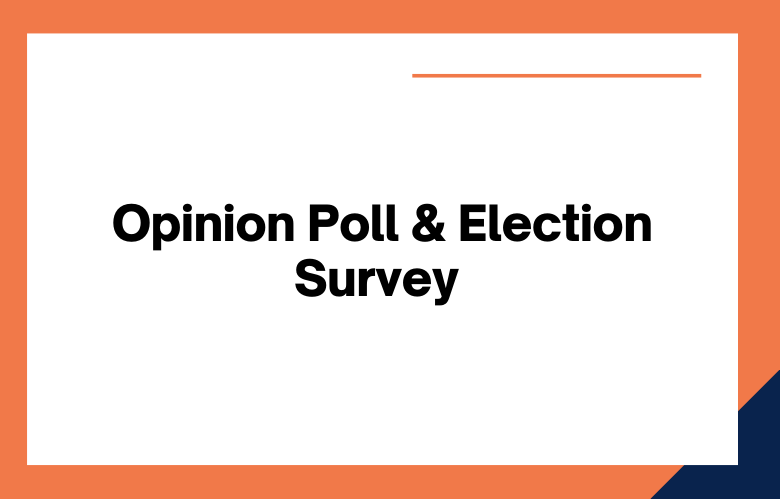It’s no secret that opinion polls and election surveys can be powerful tools for understanding how the public feels about political candidates and issues. But what are the best practices for conducting these surveys? We would survey some of the most important considerations when conducting an opinion or election survey.
The accuracy of opinion polls and election surveys is always a hot topic. In close races, pollsters can make or break a candidate’s chances of winning. But what are the best practices for conducting these polls? And how can you trust the results?
Here are some tips for polling accuracy and things to watch out for with survey results.
In the weeks leading up to a national election, candidates and their supporters bombard Americans with messages through various forms of media.
There are some tools to help us make informed decisions.
Opinion polls and election surveys are two of these tools.
But how do you know which is to trust? And what should we look for in good poll or survey results? This blog post will discuss best practices for interpreting opinion polls and election surveys.
We’ll also explore how these tools can help us make informed voting decisions.
What is an Opinion Poll?
Opinion polls are surveys that gauge public opinion on a particular issue. Governments and businesses often use them to calculate people’s views on various issues.
An opinion poll, often called a vote, is a human research survey of public opinion from a particular sample.
They are designed to represent the opinions of a population by providing statistical methods and are common uses in politics, marketing, and social research.
An opinion poll is a way of determining what people think about a particular issue. They conduct by asking a group of people questions. The results of opinion polls help make decisions about things like policy and public opinion.
It seems like everywhere you turn, someone is asking for your opinion. But what exactly is an opinion poll?
An opinion poll is a set of questions to gauge public opinion on a particular issue. Opinion polls use businesses, governments, and other organizations to gather data about what people think about a specific topic.
Opinion polls can research various topics, from politics to pop culture. And while they may seem like a relatively recent invention, opinion polls have existed for centuries.
So next time you ask for your opinion, remember you’re participating in a long and rich history.
An opinion poll is a way of determining what people think about something. You ask a group of people their opinion, and then you can see how many agree or disagree.
Opinion polls are tools researchers use to gather information about people’s opinions on various issues. They often gauge public opinion on controversial topics or track statements’ changes over time.
What is an Election Survey?
It’s a way to collect data about people’s opinions on various political issues. Election surveys can gauge public opinion on various topics, from the economy to national security.
Researchers have found that surveying voters before an election can be a valuable tool to identify how the vote might swing. However, not all surveys are created equal. Some election surveys are more reliable than others, and the quality of their data can vary greatly.
When choosing an election survey to rely on, it’s essential to consider factors such as sample size, methodology, and past accuracy.
Surveys are essential tools that help us gauge public opinion on various topics. They can measure voter preferences in an election or understand how the public feels about a particular issue.
Election surveys can help candidates make informed decisions about their campaign strategy and support the media’s better understanding of important issues to voters.
Opinion Poll and Election Survey Best Practices
- When designing your survey, please keep it simple and easy to understand
- Make sure the questions are relevant to your target audience
- Ask closed-ended questions whenever possible so that respondents can only choose from a limited number of answers
- Keep the length of your survey as short as possible- no one wants to spend too much time filling out a form
- Use clear and concise language throughout the questionnaire
- Test your survey on a small group of people before releasing it to the public
- Analyze the results and use them to improve your next poll or election survey
- When creating an opinion poll or election survey, make sure to keep your questions short
- Keep the language of your questions neutral
- Make sure to test your survey on a small group of people before releasing it to the public.
- Use reputable polling companies to collect data.
- Release surveys at regular intervals rather than all at once
- Interpret the data correctly and be transparent about your findings
- Thank participants for their time
- Keep the survey short- no more than ten questions
- Make sure the questions are unambiguous
- Test the survey on a small group of people before releasing it to the public.
- Use a neutral tone of voice when asking questions about political opinions
- Be respectful of respondents and their time
- Thank respondents for their participation
- When creating your survey, be sure to keep it short
- Avoid leading questions that could influence respondents’ answers
- Be transparent about how data use
- Please keep track of who has participated in the survey and remove them from subsequent surveys.
- When creating your survey, be sure to keep it short and simple
- Make specific the questions are relevant to your target audience
- Ask closed-ended questions that quickly score
- Be clear about what you plan to do with the data you collect
- Keep track of who has participated in your survey
- Decide on the purpose of your survey
- Choose the correct type of survey for your needs
- Create a clear and concise questionnaire
- Gather a representative sample size
- Use reliable and valid polling methods
- Analyze results and draw conclusions
- Report findings to stakeholders
- Create a questionnaire that is clear and concise
- Gather responses from qualified respondents
- Analyze the data and draw conclusions
- When designing your survey, ensure it is easy to read and visually appealing.
- Use various question types- closed-ended, multiple-choice, rating scales, etc.
- Ask demographic questions at the beginning of the survey so you can analyze the data later.
- Make sure the questions are relevant to your target audience
- Pilot test your survey before you send it out to respondents
- Send surveys via email or use online survey tools
- Analyze the results and draw conclusions
Conclusion
As we end this blog post, it’s important to remember that running a successful opinion poll or election survey takes careful planning and execution. If you would like help with your next polling project. We have years of experience conducting polls and surveys for businesses and political organizations of all sizes.
Contact us about the services, or visit our website to learn more about how we can help you collect data that will Influence the Conversation!
Opinion Poll and Election Survey Best Practices: FAQs
What Are Opinion Polls In The Context Of Elections
Opinion polls are surveys conducted to gauge public sentiment, voting intentions, and key political issues before an election.
Why Are Opinion Polls Important For Political Campaigns
They help campaigns understand voter priorities, measure candidate popularity, and adjust strategies based on real-time insights.
What Is The Difference Between Opinion Polls And Exit Polls
Opinion polls are conducted before voting takes place, while exit polls are conducted immediately after voters have cast their ballots.
How Can Election Surveys Influence Voter Behavior
Surveys can shape perceptions by highlighting leading candidates or trending issues, potentially swaying undecided voters.
What Are The Key Elements Of A Reliable Opinion Poll
Key elements include a representative sample size, unbiased questions, transparent methodology, and credible data analysis.
How Does Sampling Affect The Accuracy Of Election Surveys
A well-designed sample ensures that the survey reflects the demographics of the voting population, reducing bias.
Why Is Question Design Critical In Opinion Polls
Poorly worded or leading questions can skew results and reduce the credibility of the poll.
What Are Common Mistakes In Conducting Election Surveys
Mistakes include using biased samples, ignoring margin of error, misinterpreting data, and failing to disclose methodology.
How Can Pollsters Ensure Transparency In Their Surveys
By publishing full methodologies, sample details, funding sources, and data analysis techniques for public review.
What Is The Role Of Margin Of Error In Opinion Polls
It indicates the level of uncertainty in results, helping interpret the accuracy and reliability of the findings.
How Can Technology Improve Election Surveys
Digital tools, AI analytics, and online platforms can speed up data collection, improve targeting, and reduce costs.
What Are The Ethical Considerations In Conducting Political Opinion Polls
Ethics include avoiding manipulation, respecting respondent privacy, and presenting results truthfully.
How Can Election Surveys Be Used For Campaign Strategy
Survey data can guide messaging, target demographics, resource allocation, and issue prioritization.
What Are Best Practices For Reporting Opinion Poll Results
Best practices include clear visuals, plain-language summaries, transparent sources, and context for interpreting findings.
How Can Public Misinterpretation Of Polls Be Avoided
By educating audiences on sampling, margin of error, and the difference between trends and final results.
What Are The Risks Of Over-Reliance On Opinion Polls
Over-reliance can lead to complacency, strategic missteps, or ignoring qualitative insights from the ground.
How Can Social Media Data Be Integrated Into Election Surveys
Social listening tools can identify emerging issues, voter sentiment trends, and online influence patterns.
What Is The Difference Between Quantitative And Qualitative Election Research
Quantitative research uses numerical data to measure trends, while qualitative research focuses on in-depth opinions and motivations.
How Can International Best Practices Be Applied To Indian Election Polls
By adopting global standards in sampling, methodology, transparency, and data analysis while adapting to local contexts.
What Are The Limitations Of Opinion Polls In Predicting Election Outcomes
Limitations include changing voter sentiment, inaccurate self-reporting, and unexpected turnout patterns.
One way to get in touch is by filling out our online form on this site or give us a call at
+91 9848321284. Let’s work together today!











